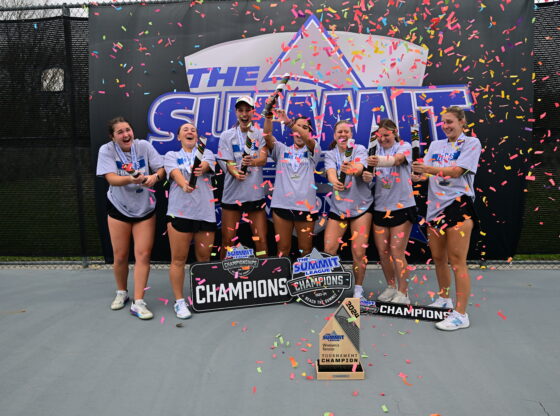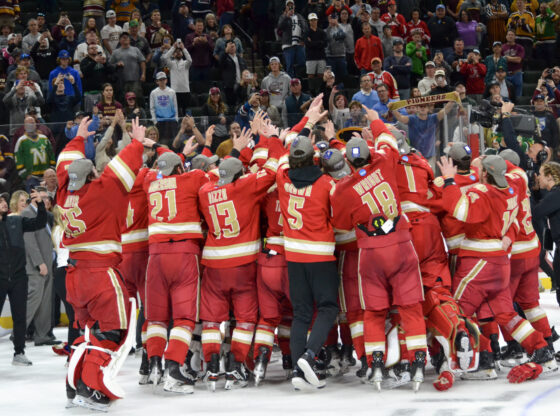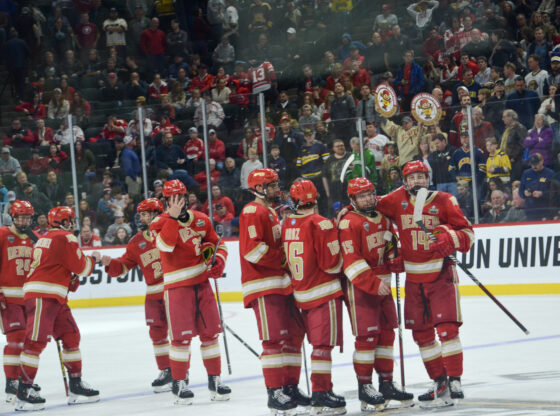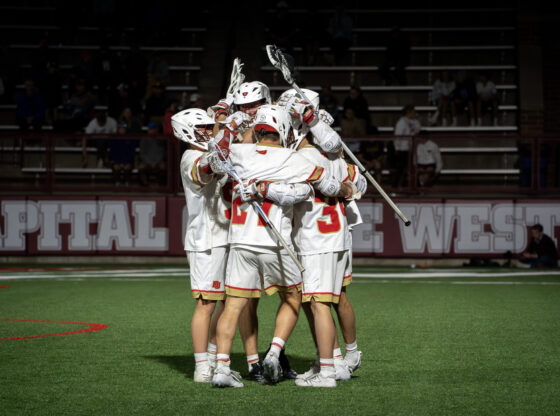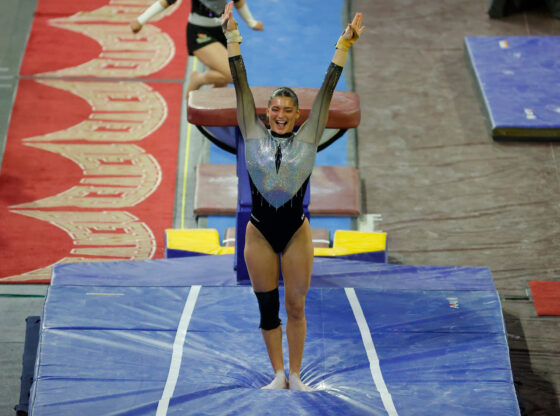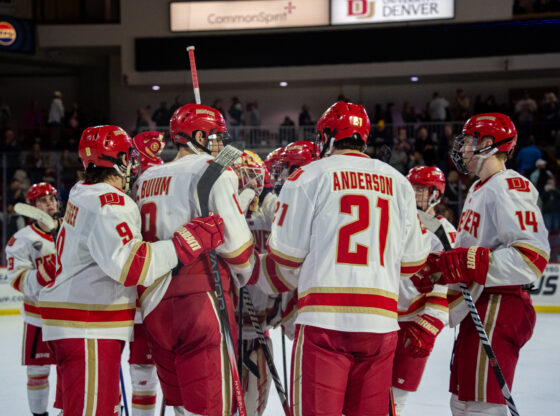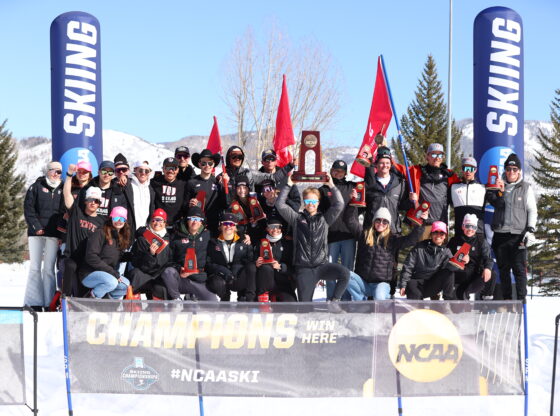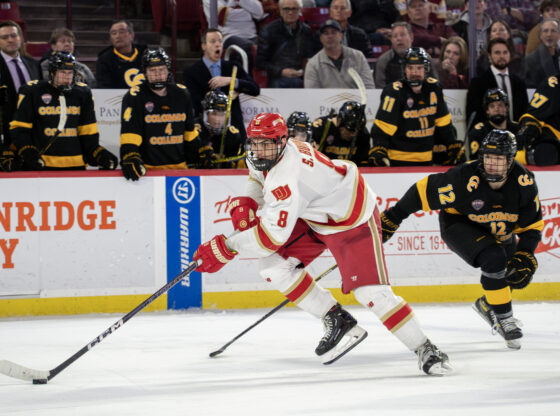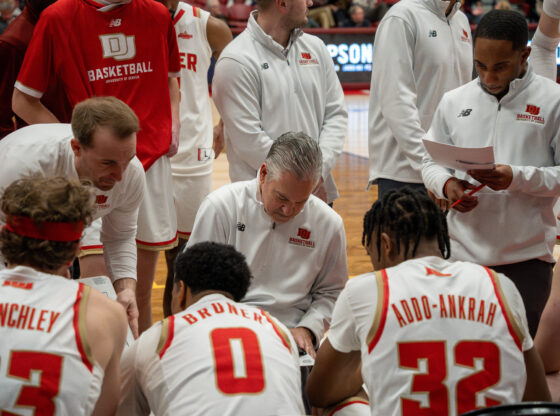The 2024 Frozen Four tournament brought with it few surprises. Alongside third-ranked Denver winning their NCAA-best tenth national tournament, the number one and two overall seeds in Boston College and Boston University also made the dance, with Michigan being the only lower seed to upset their regional tournament, taking down Michigan State in the Elite Eight.
BC, BU, DU and Michigan can all be classified as college hockey bluebloods, each with at least five national titles to their name. But these teams have something striking in common outside of their continued national success: their youth.
When looking at a list of the oldest teams in college hockey this year, each of this year’s Frozen Four schools is near the very end of the list. Disregarding the closest thing we have to a Cinderella story this year in Michigan, the remaining three schools, which are also the top three rated teams in the nation, are all in the bottom four when it comes to average roster age.
BU finds itself tied for fourth youngest with the recently-upset Michigan State, at an average age of 21 years and four months. The newly-crowned Denver is the second youngest, with their nine freshmen bringing the average down to 21 years flat, while the BC Eagles are the youngest team in the NCAA: just 20 years and nine months.
Is there a correlation here? Are college hockey teams going to start moving toward younger rosters? Or is this some fluke that reflects one of the best freshman classes in recent college hockey memory?
Firstly, some hockey history. The NCAA hosted the first college hockey season in 1947-48, but it did not become a reliable path to professional hockey until much later. The vast majority of NHL players came from the biggest junior hockey league in Canada, the Ontario Hockey League (OHL), which later merged with two other provincial leagues into the Canadian Hockey League (CHL), while NHL draft picks out of college were few and far between.
It wasn’t until 1984 that more than one NCAA player was picked in the first round of the same entry draft: David Quinn of BU and Craig Redmond of Denver were both taken that year. After that, college draftees steadily increased, but CHL picks still heavily outnumbered them.
As a result, college hockey throughout most of the 20th century was seen as an older, slower and less-skilled league than the CHL. Part of this was out of necessity: the CHL was U-20 while the NCAA regularly saw players as old as 26 suit up. But how is this changing?
The NCAA is still an older league than the CHL—with age limits and typical college timeframes, this will never change. But now more than ever, young skilled hockey players are showing off their talents south of the border in university arenas, and NHL teams are consistently ready to draft them.
Last year, no fewer than nine D-I committed players were selected by NHL teams in the first round, continuing a trend that has only grown stronger in the last decade. And interestingly, for the top teams in the nation, it is these young players who are making the biggest difference.
BC’s wealth of youth carried them throughout the season. Three of their top four scorers are freshmen who were drafted last summer, including Ryan Leonard, Gabe Perreault and the top scorer in the nation, Will Smith. A sophomore rounds out the top four: Hobey Baker nominee Cutter Gauthier. Their star goalie, Jacob Fowler, is also a freshman.
BU boasts who is almost certainly going to be the number one overall pick at this year’s NHL entry draft: the 17 (yes, seventeen) year-old freshman phenom and Hobey Baker winner, Macklin Celebrini, who finished the season behind only Smith and Gauthier in the national scoring race. The sophomore Hutson brothers, Lane and Quinn, round out the top three BU scorers but trail Celebrini by at least fifteen points each.
Denver is a bit of an exception to the trend of those under the age of 20 leading the way. Jack Devine and Massimo Rizzo, both juniors, have been the big scorers for Denver this year, with Rizzo remaining in the top three despite missing over ten games. However, it’s impossible to ignore 18-year-old freshman Zeev Buium, who has been dazzling Denver and national audiences alike all season. Buium is set to become Denver’s first round-one NHL draftee since Henrik Borgstrom in 2016.
Michigan, although finding itself neither in the top three national seeds nor the bottom four oldest rosters, still sits as the 11th youngest team in college hockey (21 years and eight months). Their top two scorers, sophomores Gavin Brindley and Rutger McGroarty, both only turn 20 this year.
The trend is clear: The best players in college hockey, playing for the best teams, are younger than ever. These players have been drafted, or will be drafted, by professional hockey franchises and will leave college in most cases before their 21st birthdays, if not earlier.
As the Celebrinis, Buiums and Smiths of the hockey world find individual and team success in the NCAA, they will only attract more top youngsters to play college hockey. The new rules surrounding Name, Image, Likeness (NIL) in the NCAA will help incentivize this move as well.
But this youthful shift isn’t just the start of something limited to college hockey: It could be a sign of the NCAA one day becoming the top development hockey league in North America.
For decades, the CHL was the pinnacle of hockey development, while college hockey players were seen as old, slow and quite bluntly not fit for professional hockey. But never in history have we seen more youth or skill in the NCAA, while more former college hockey players are making names for themselves in the NHL than ever before.
College hockey is on the rise, and the kids are leading the charge.


